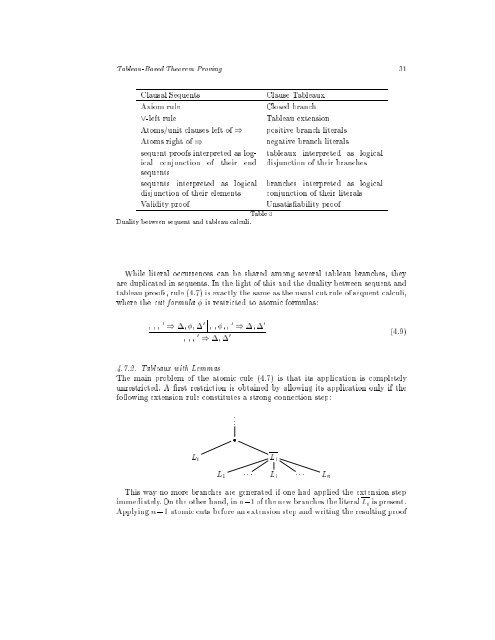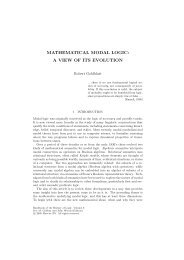Create successful ePaper yourself
Turn your PDF publications into a flip-book with our unique Google optimized e-Paper software.
<strong>Tableau</strong>-<strong>Based</strong> <strong>Theorem</strong> <strong>Proving</strong> 31Clausal SequentsAxiom rule_-left ruleAtoms/unit clauses left of )Atoms right of)sequent proofs interpreted as logicalconjunction of their endsequentssequents interpreted as logicaldisjunction of their elementsValidity proofDuality between sequent and tableau calculi.Clause <strong>Tableau</strong>xClosed branch<strong>Tableau</strong> extensionpositive branch literalsnegative branch literalstableaux interpreted as logicaldisjunction of their branchesbranches interpreted as logicalconjunction of their literalsUnsatisability proofTable 3While literal occurrences can be shared among several tableau branches, theyare duplicated in sequents. In the light of this and the duality between sequent andtableau proofs, rule (4.7) is exactly the same as the usual cut rule of sequent calculi,where the cut formula is restricted to atomic formulas:,; , 0 ) ;; 0 ,;;, 0 ) ; 0,; , 0 ) ; 0 (4.9)4.7.2. <strong>Tableau</strong>x with LemmasThe main problem of the atomic cule (4.7) is that its application is completelyunrestricted. A rst restriction is obtained by allowing its application only if thefollowing extension rule constitutes a strong connection step:.L iL iL 1 L i L nThis way no more branches are generated if one had applied the extension stepimmediately. On the other hand, in n,1 of the new branches the literal L i is present.Applying n,1 atomic cuts before an extension step and writing the resulting proof
















